Winds over the Red Sea and NE African Summer Climate
Abstract
1. Introduction
2. Data Analysis
3. Results
3.1. Mesoscale Structure and Temporal Characteristics
3.2. Time-Space Field Correlations: May–July 1980–2023
3.3. Wind Surge and Dust Plume in May–July 2015
3.4. Diurnal Analysis in May–July 2015
3.5. Seasonal Impacts
4. Concluding Discussion
Supplementary Materials
Funding
Acknowledgments
Conflicts of Interest
References
- Ralston, D.K.; Jiang, H.; Ferrar, T.F. Waves in Red Sea: Response to monsoonal and mountain gap winds. Cont. Shelf Res. 2013, 65, 1–13. [Google Scholar] [CrossRef]
- Langodan, S.; Cavaleri, L.; Viswanadhapalli, Y.; Hoteit, I. The Red Sea: A natural laboratory for wind and wave modeling. J. Phys. Oceanogr. 2014, 44, 3139–3159. [Google Scholar] [CrossRef]
- Krishnamurti, T.N.; Wong, V.; Pan, H.L.; Pasch, R.; Molinari, J.; Ardanuy, P. Three dimensional planetary boundary layer model for the Somali Jet. J. Atmos. Sci. 1983, 40, 894–908. [Google Scholar] [CrossRef]
- Jiang, H.; Farrar, J.T.; Beardsley, R.C.; Chen, R.; Chen, C. Zonal surface wind jets across the Red Sea due to mountain gap forcing along both sides of the Red Sea. Geophys. Res. Lett. 2009, 36, L19605. [Google Scholar] [CrossRef]
- Davis, S.R.; Pratt, L.J.; Jiang, H. The Tokar Gap jet: Regional circulation, diurnal variability and moisture transport based on numerical simulations. J. Clim. 2015, 28, 5885–5907. [Google Scholar] [CrossRef]
- Davis, S.R.; Farrar, J.T.; Weller, R.A.; Jiang, H.; Pratt, L.J. The land-sea breeze of the Red Sea: Observations, simulations, and relationships to regional moisture transport. J. Geophys. Res. Atmos. 2019, 124, 13803–13825. [Google Scholar] [CrossRef]
- Pratt, L.J.; Albright, E.J.; Rypina, I.; Jiang, H. Eulerian and Lagrangian comparison of wind jets in the Tokar Gap region. Fluids 2020, 5, 193. [Google Scholar] [CrossRef]
- Masiwal, R.; Dixit, V.; Seshadri, A.K. Explaining dynamics and rapid onset of the Somali Jet through its kinetic energy budget. J. Atmos. Sci. 2023, 80, 833–847. [Google Scholar] [CrossRef]
- Bannon, P.R. On the dynamics of the East African Jet. I: Simulations of mean conditions for July. J. Atmos. Sci. 1979, 36, 2139–2152. [Google Scholar] [CrossRef]
- Bannon, P.R. On the dynamics of the East African jet. II: Arabian Sea branch. J. Atmos. Sci. 1982, 39, 2267–2278. [Google Scholar] [CrossRef]
- Vizy, E.K.; Cook, K.H. Connections between the summer east African and Indian rainfall regimes. J. Geophys. Res. 2003, 108, 4510. [Google Scholar] [CrossRef]
- Mafimbo, A.J.; Reason, C.J.C. Air-sea interaction over the upwelling region of the Somali coast. J. Geophys. Res. 2010, 115, C01001. [Google Scholar] [CrossRef]
- Zhai, P.; Bower, A. The response of the Red Sea to a strong wind jet near the Tokar Gap in summer. J. Geophys. Res. Ocean. 2013, 118, 422–434. [Google Scholar] [CrossRef]
- Langodan, S.; Cavaleri, L.; Vishwanadhapalli, Y.; Pomaro, A.; Bertotti, L.; Hoteit, I. The climatology of the Red Sea—Part 1: The wind. Intl. J. Climatol. 2017, 37, 4509–4517. [Google Scholar] [CrossRef]
- Winker, D.M.; Hunt, W.M.; McGill, M.J. Initial performance assessment of CALIOP. Geophys. Res. Lett. 2007, 34, L19803. [Google Scholar] [CrossRef]
- Stephens, G.L.; Vane, D.G.; Boain, R.J.; Mace, G.G.; Sassen, K.; Wang, Z.; Illingworth, A.J.; O’connor, E.J.; Rossow, W.B.; Durden, S.L.; et al. The CloudSat Mission and the A-Train. Bull. Amer. Meteo. Soc. 2002, 83, 1771–1790. [Google Scholar] [CrossRef]
- Saha, S.; Moorthi, S.; Wu, X.; Wang, J.; Nadiga, S.; Tripp, P.; Behringer, D.; Hou, Y.T.; Chuang, H.Y.; Iredell, M.; et al. The NCEP climate forecast system v2. J. Clim. 2014, 27, 2185–2208. [Google Scholar] [CrossRef]
- Funk, C.C.; Peterson, P.J.; Landsfeld, M.F.; Pedreros, D.H.; Verdin, J.P.; Rowland, J.D.; Romero, B.E.; Husak, G.J.; Michaelsen, J.C.; Verdin, A.P. A quasi-global precipitation time series for drought monitoring. U.S. Geol. Surv. Data Ser. 2014, 832, 4. [Google Scholar]
- Hersbach, H.; Bell, B.; Berrisford, P.; Hirahara, S.; Horányi, A.; Muñoz-Sabater, J.; Nicolas, J.; Peubey, C.; Radu, R.; Schepers, D.; et al. The ERA5 global reanalysis. Qtr. J. R. Meteo. Soc. 2020, 146, 1999–2049. [Google Scholar] [CrossRef]
- Stein, A.F.; Draxler, R.R.; Rolph, G.D.; Stunder, B.J.; Cohen, M.D.; Ngan, F. NOAA HYSPLIT atmospheric transport and dispersion modeling system. Bull. Amer. Meteor. Soc. 2015, 96, 2059–2077. [Google Scholar] [CrossRef]
- Molod, A.; Takacs, L.; Suarez, M.; Bacmeister, J. Development of the GEOS-5 atmospheric general circulation model: Evolution to Merra2. Geosci. Model Dev. 2015, 8, 1339–1356. [Google Scholar] [CrossRef]
- Randles, C.A.; Silva, A.M.; Buchard, V.; Colarco, P.R.; Darmenov, A.; Govindaraju, R.; Smirnov, A.; Holben, B.; Ferrare, R.; Hair, J.; et al. The Merra2 aerosol reanalysis, 1980 onward, part I: System description and data assimilation evaluation. J. Clim. 2017, 30, 6823–6850. [Google Scholar] [CrossRef]
- Gelaro, R.; McCarty, W.; Suárez, M.J.; Todling, R.; Molod, A.; Takacs, L.; Randles, C.A.; Darmenov, A.; Bosilovich, M.G.; Reichle, R.; et al. The modern-era retrospective analysis for research and applications v2 (Merra2). J. Clim. 2017, 30, 5419–5454. [Google Scholar] [CrossRef]
- Lee, H.-T. Climate Algorithm Theoretical Basis: Daily Outgoing Longwave Radiation CDR; CDRP-ATBD-0526; NOAA: Washington, DC, USA, 2014; p. 46.
- Reynolds, R.W.; Smith, T.M.; Liu, C.; Chelton, D.B.; Casey, K.S.; Schlax, M.G. Daily high-resolution blended analyses for sea surface temperature. J. Clim. 2007, 20, 5473–5496. [Google Scholar] [CrossRef]
- Pinzon, J.E.; Tucker, C.J. A non-stationary 1981–2012 AVHRR NDVI time series. Remote Sens. 2014, 6, 6929–6960. [Google Scholar] [CrossRef]
- Hulley, G.; Freepartner, R.; Malakar, N.; Sarkar, S. MODIS Land Surface Temperature and Emissivity Product v6, NASA-GSFC-JPL; NASA: Washington, DC, USA, 2016.
- Andreae, M.O. Emission of trace gases and aerosols from biomass burning—An updated assessment. Atmos. Chem. Phys. 2019, 19, 8523–8546. [Google Scholar] [CrossRef]
- Eze, E.; Girma, A.; Zenebe, A.; Okolo, C.C.; Kourouma, J.M.; Negash, E. Predictors of drought-induced crop yield/losses in agroecologies of Tigray Ethiopia. Sci. Rep. 2022, 12, 6284. [Google Scholar] [CrossRef]
- Viste, E.; Sorteberg, A. The effect of moisture transport variability on Ethiopian summer precipitation. Int. J. Climatol. 2013, 33, 3106–3123. [Google Scholar] [CrossRef]
- Findlater, J. A major low-level air current near the Indian Ocean during the northern summer. Quart. J. Roy. Meteor. Soc. 1969, 95, 362–380. [Google Scholar] [CrossRef]
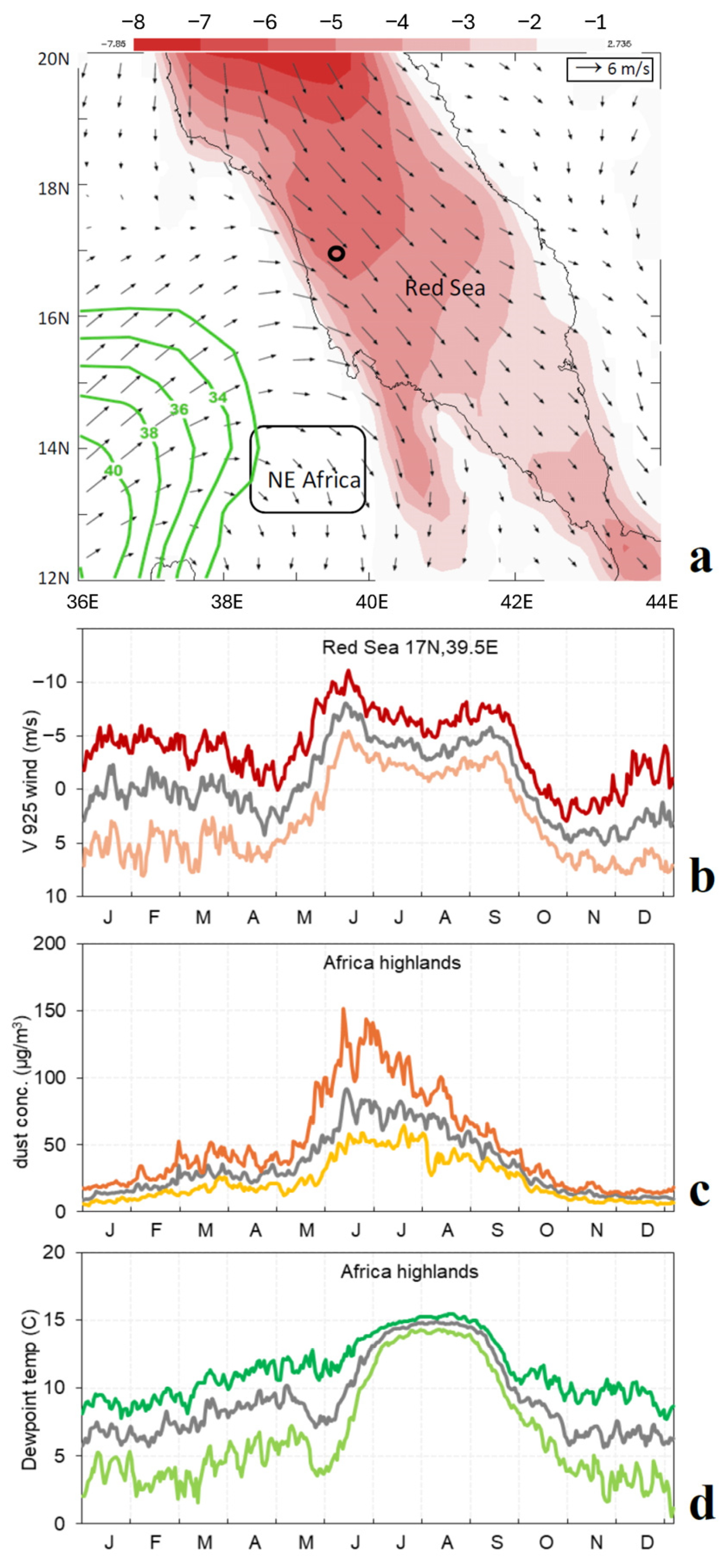
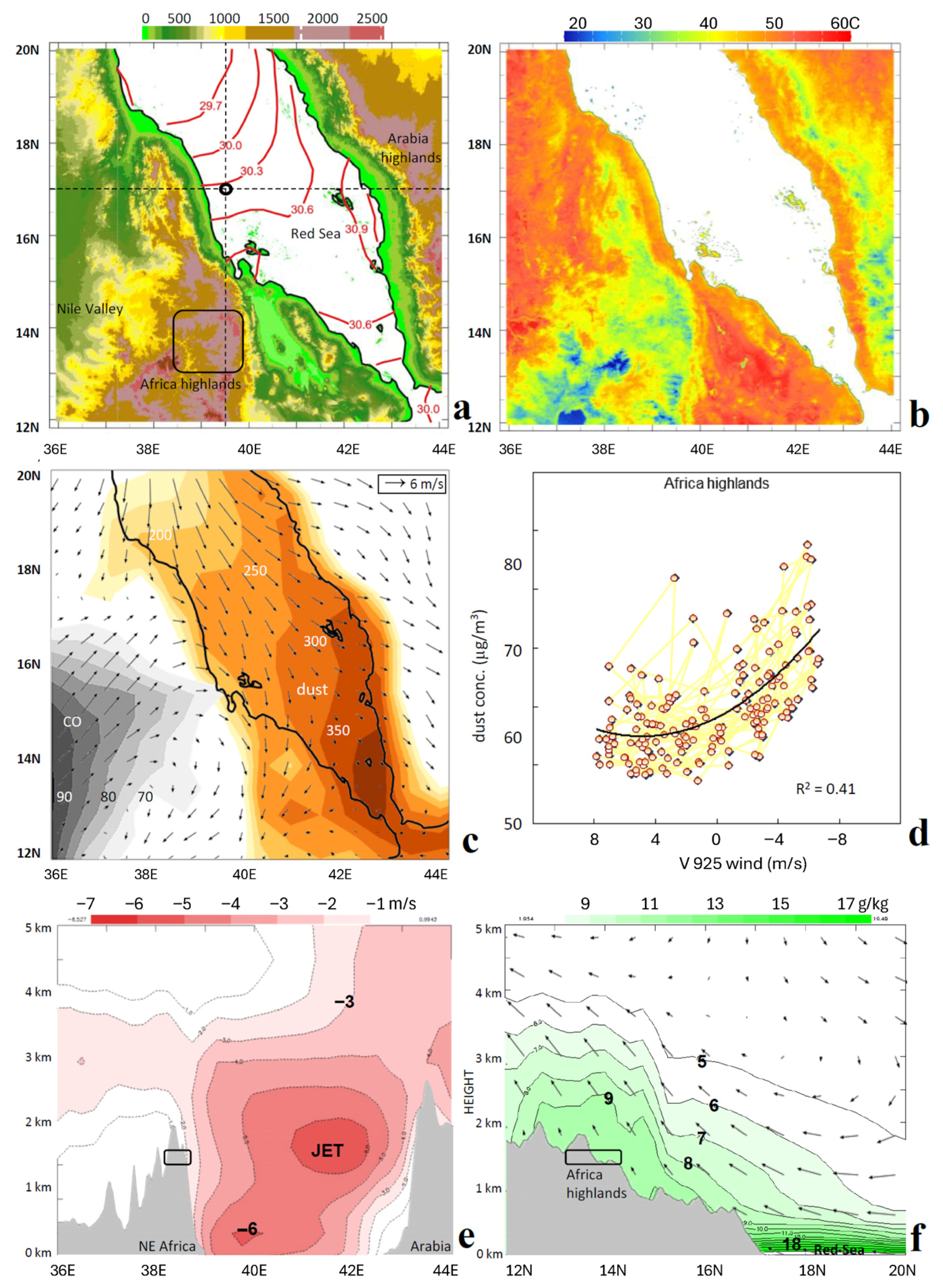
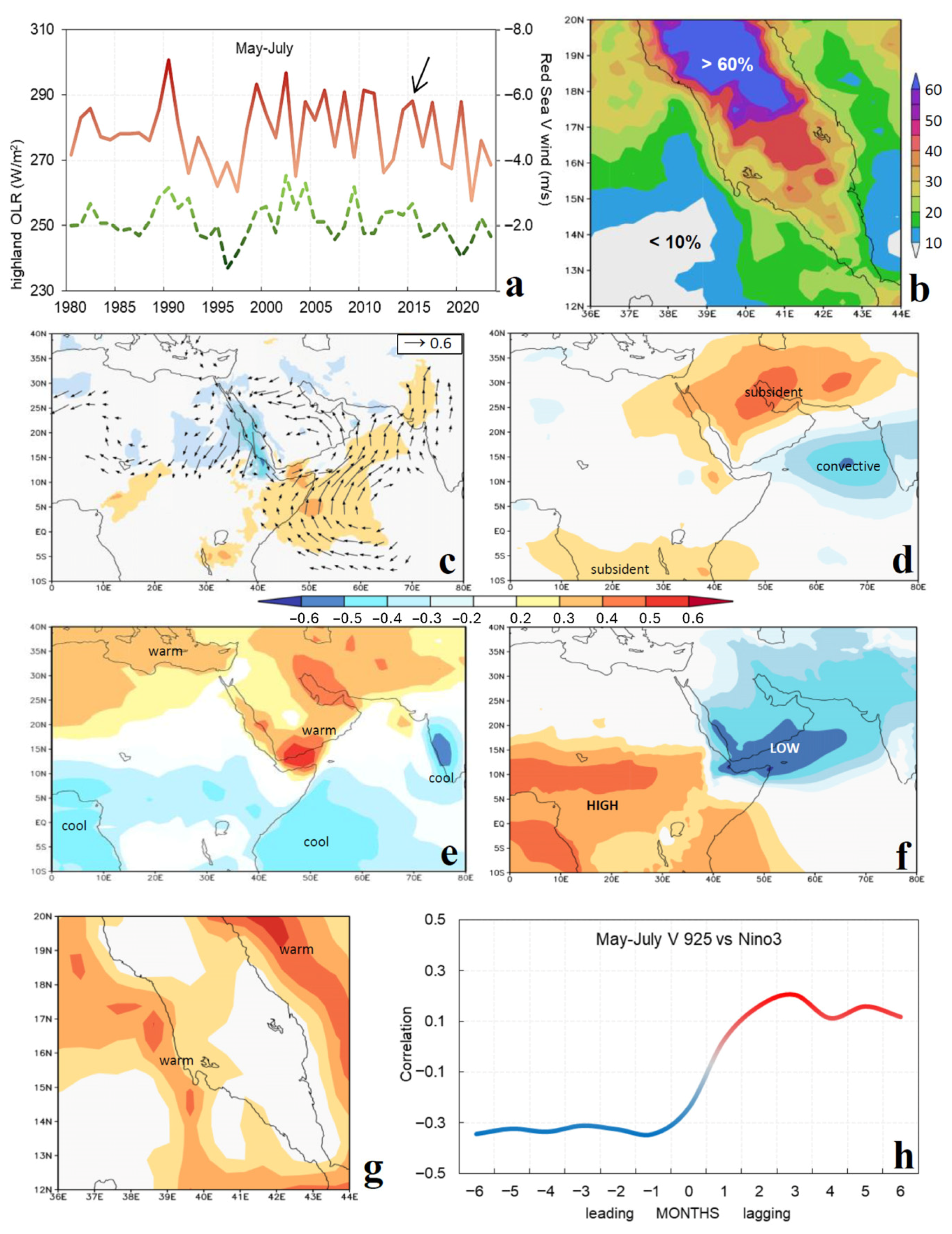
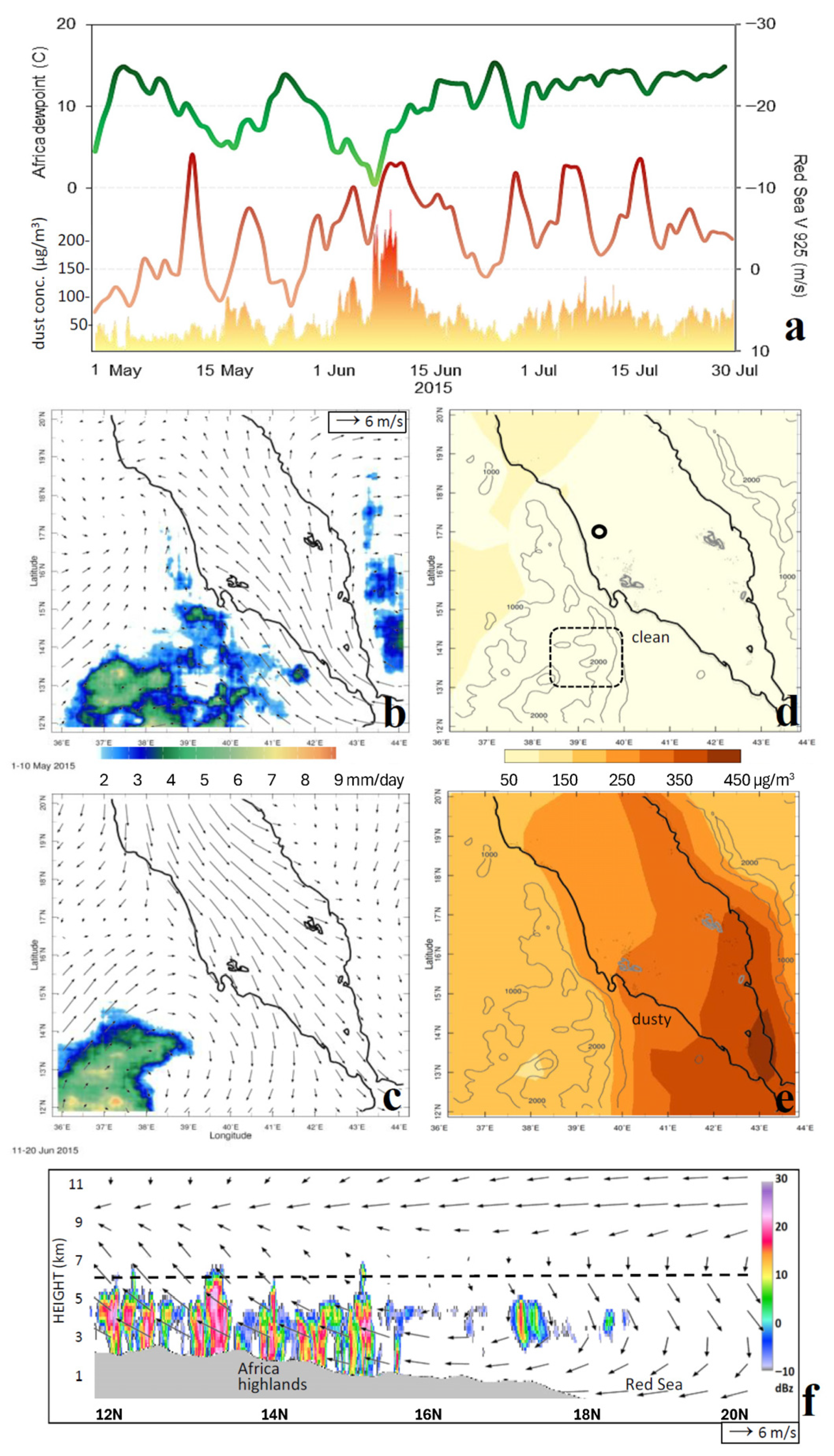
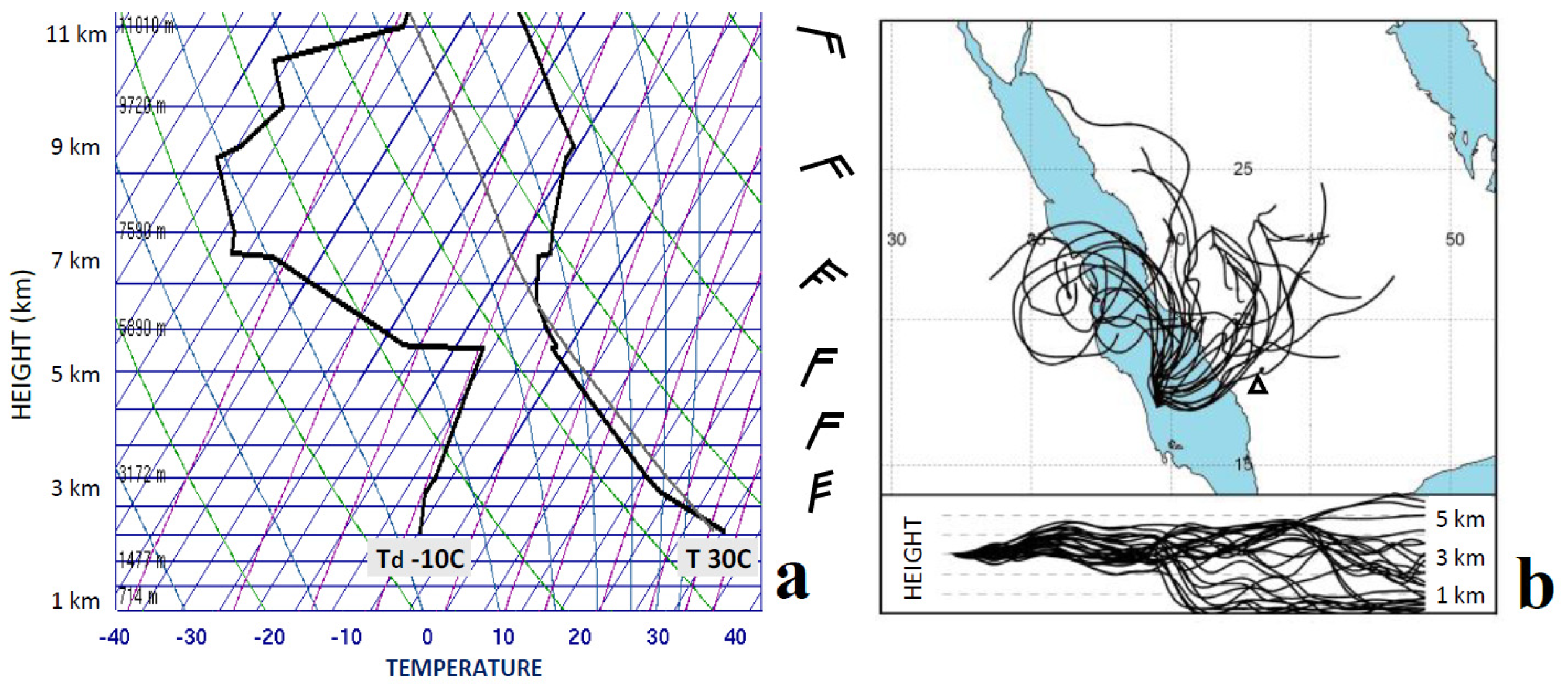
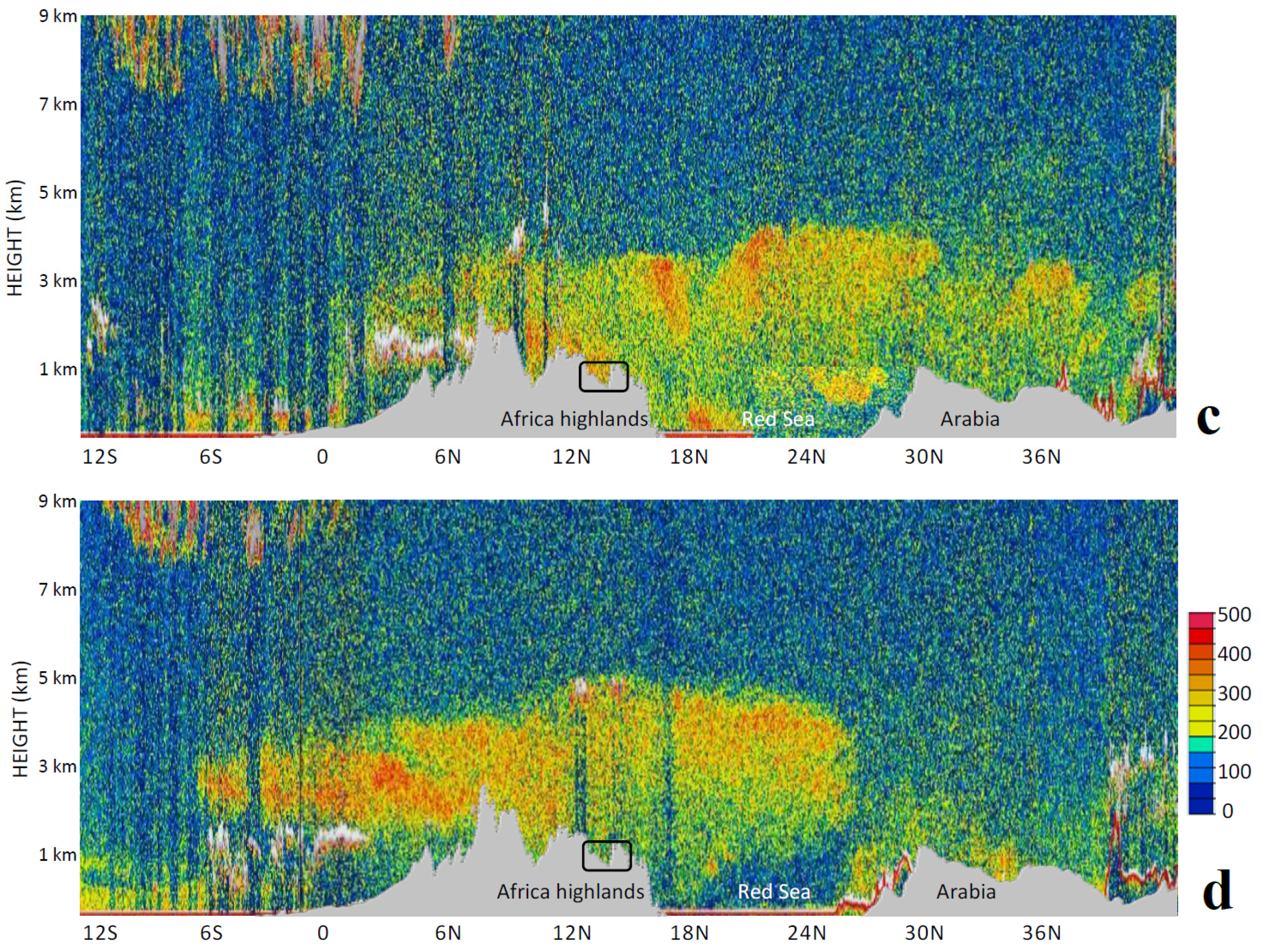
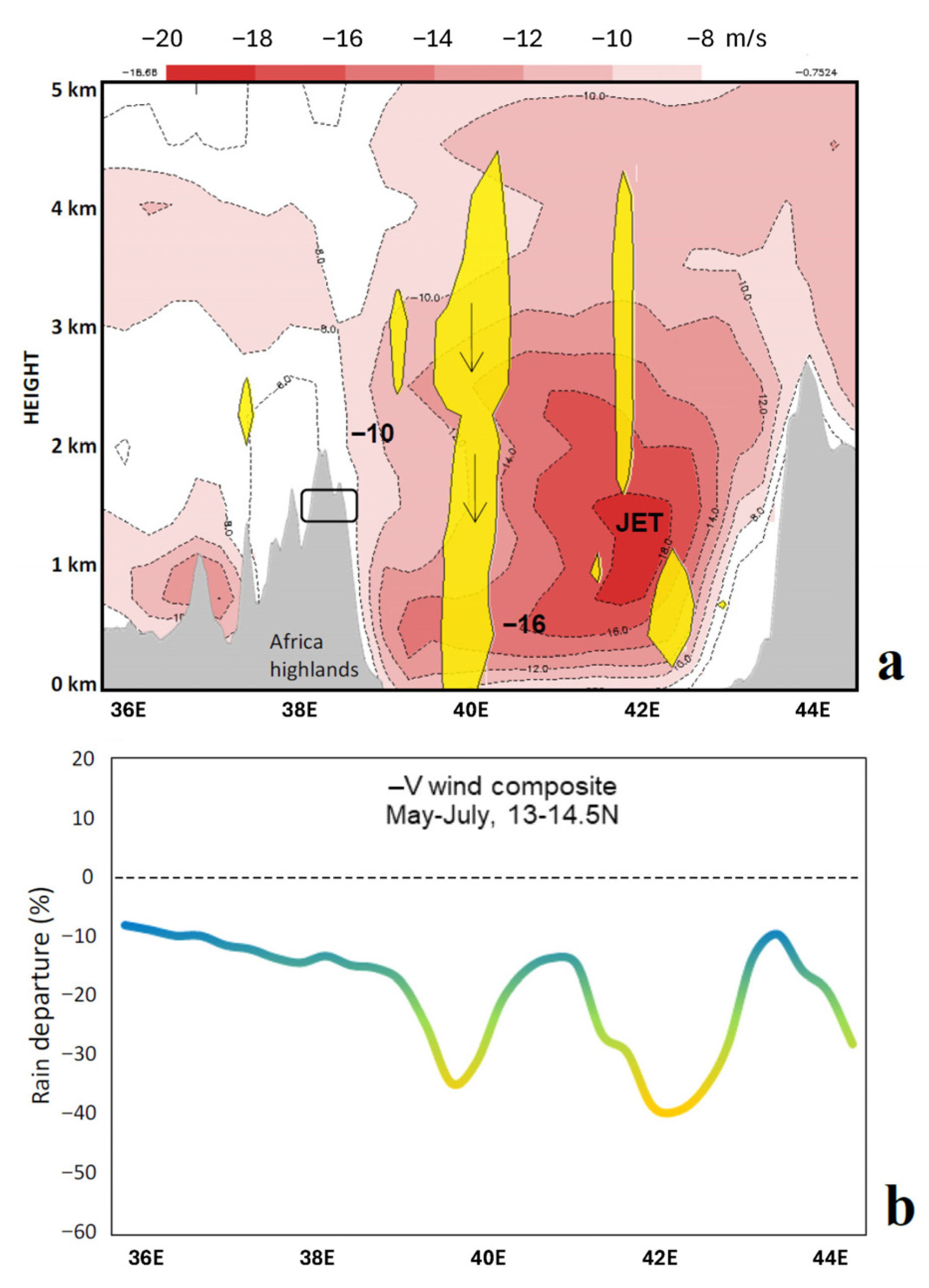
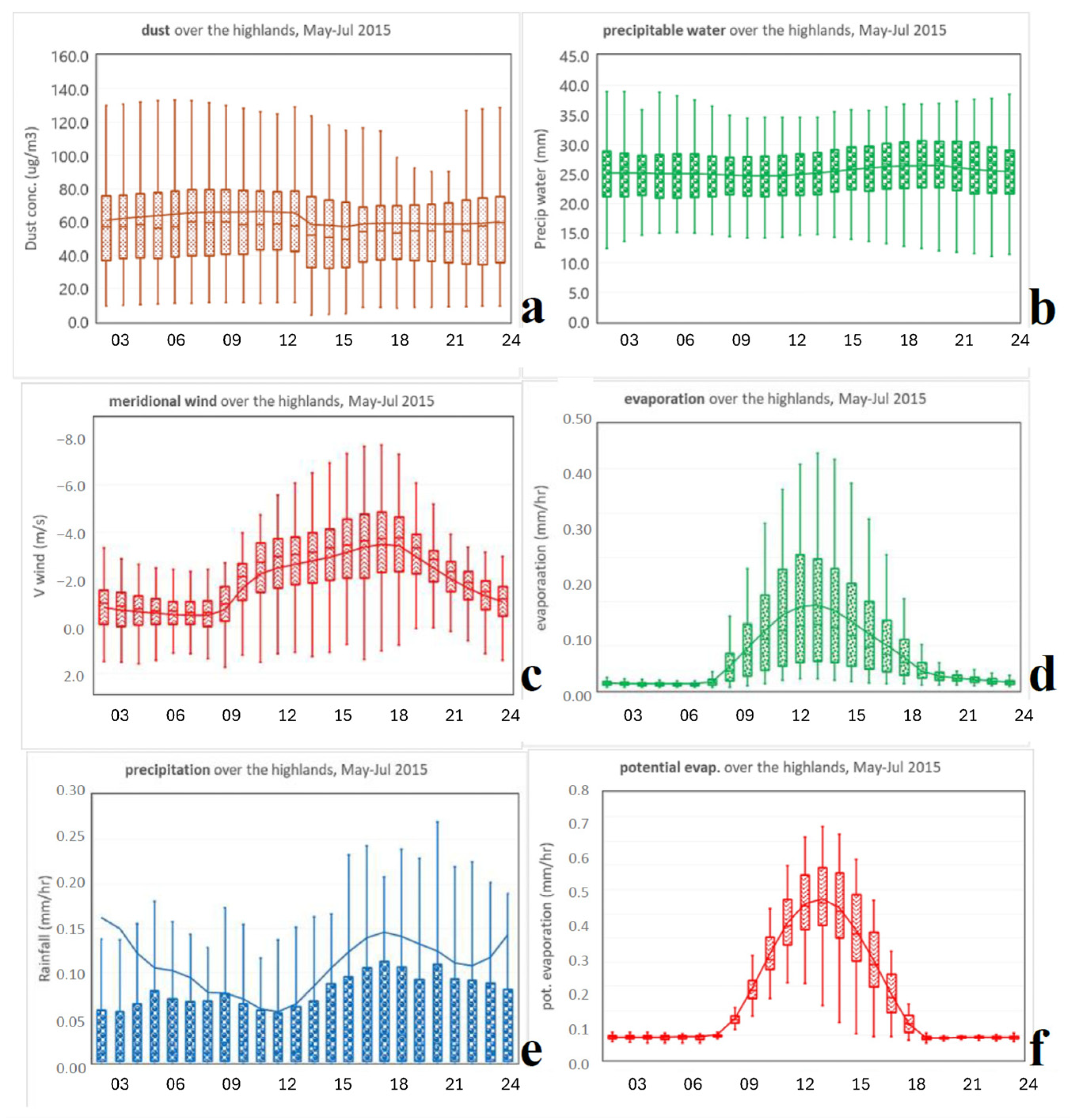
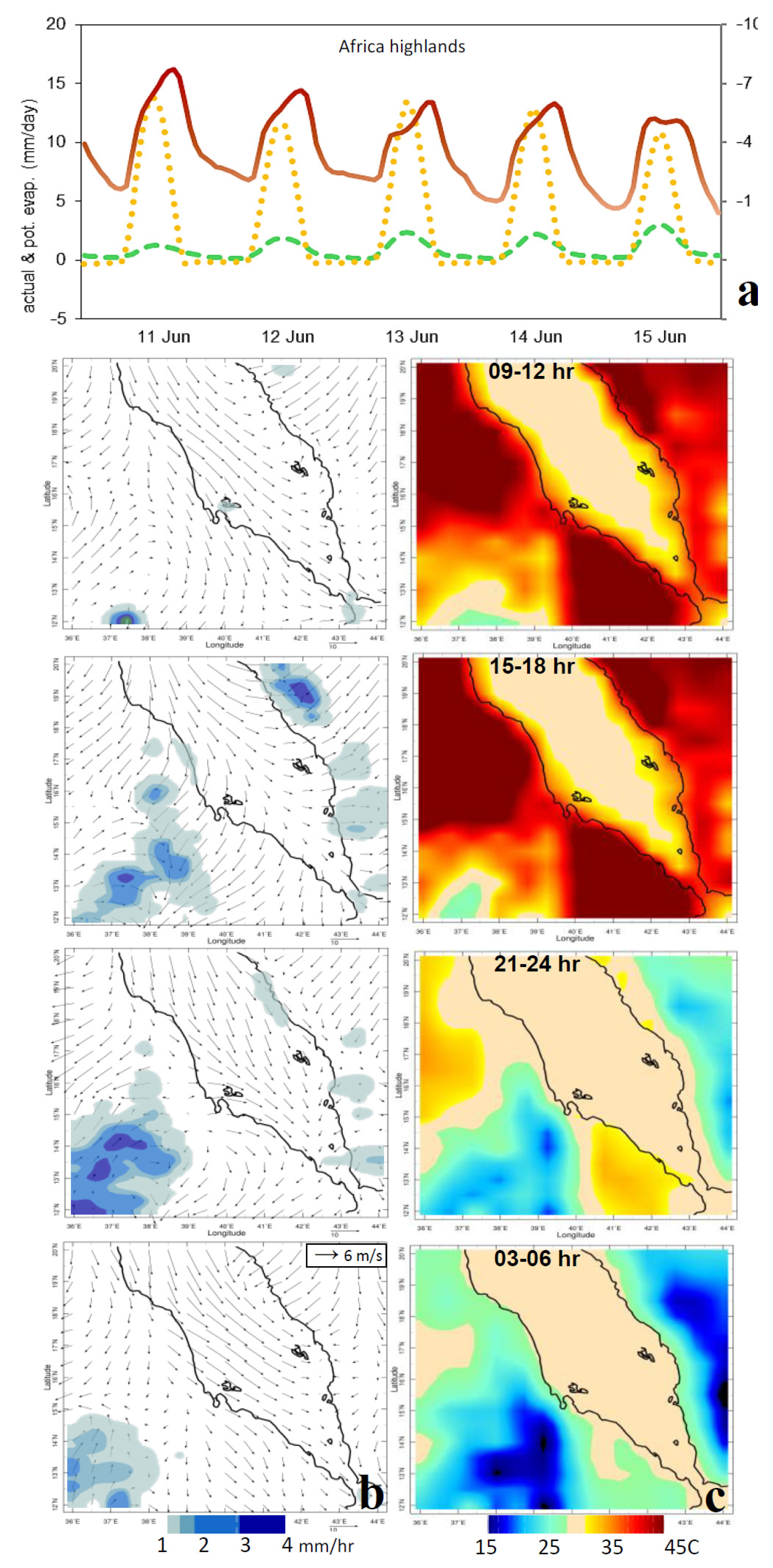
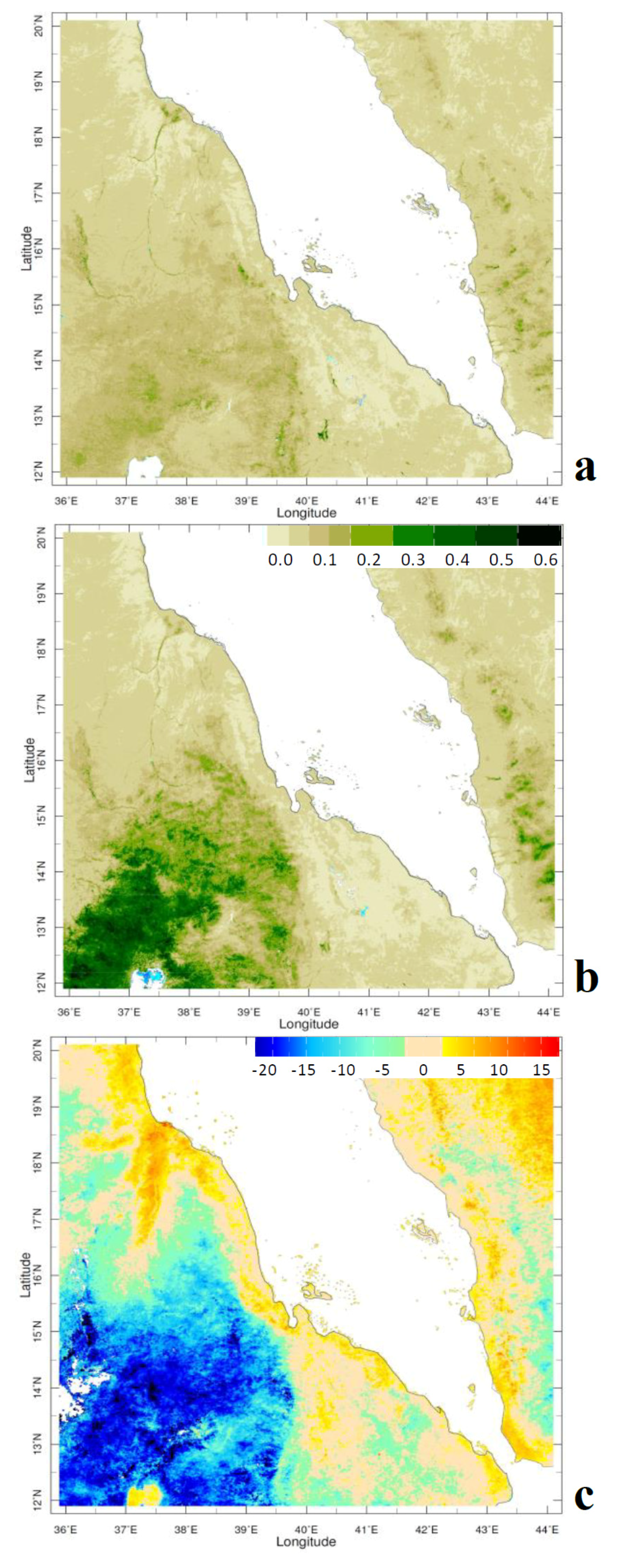
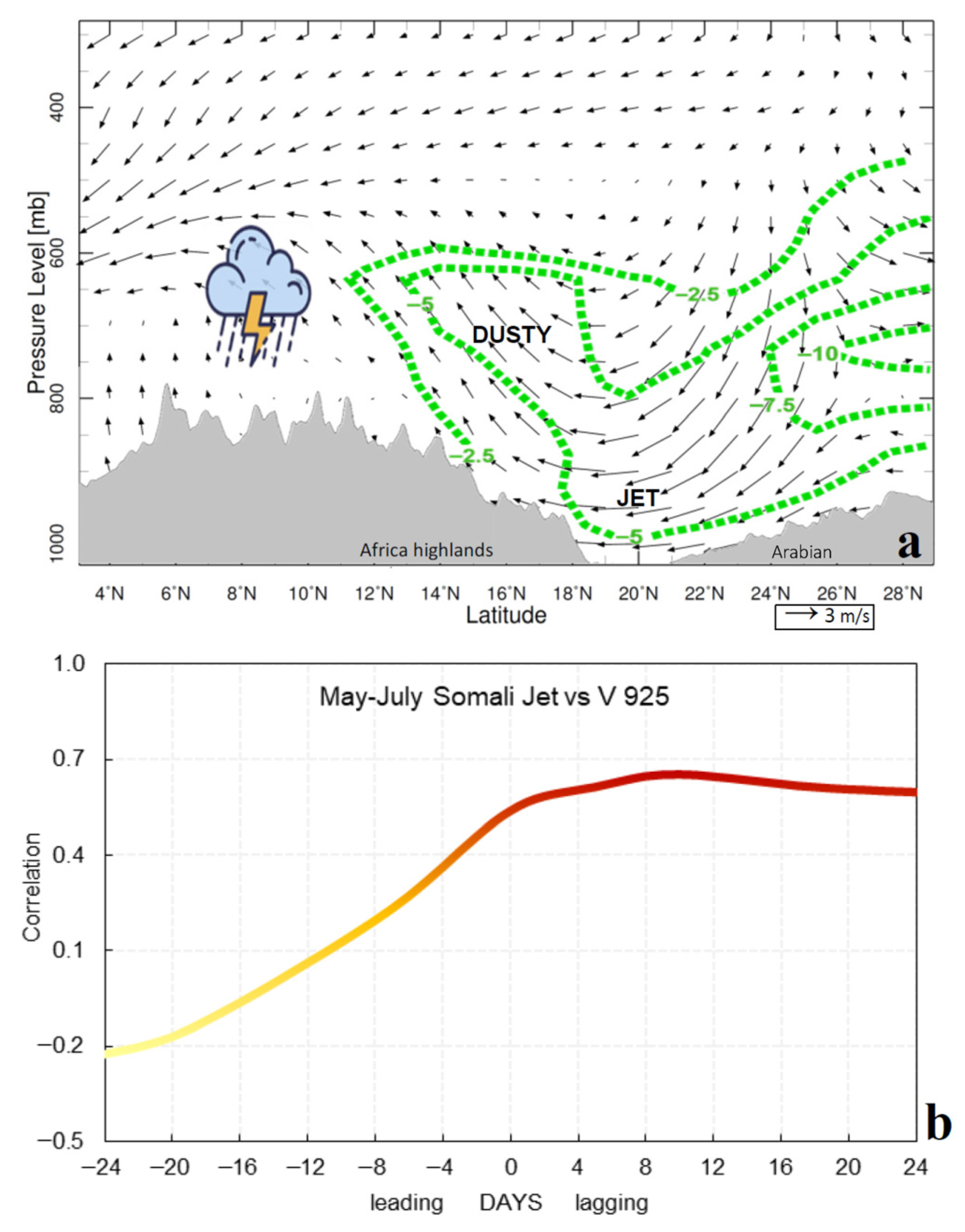
| ACRONYM | NAME (VARIABLES) | HORZ.RES. | REFERENCE |
|---|---|---|---|
| Caliop Cloudsat | Satellite aerosol lidar and microwave radar (dust extinction, cloud reflectivity) | 1 km zenith | [15,16] |
| CFS2 | Coupled Forecast System v2 reanalysis (hourly heat flux, for evaporation) | 25 km | [17] |
| Chirp | Meteosat IR cold cloud duration (rainfall) | 5 km | [18] |
| ERA5 | European Reanalysis v5 (wind, vertical motion, humidity) | 25 km | [19] |
| Hysplit | Hybrid single-particle Lagrangian-integrated trajectory model | 25 km | [20] |
| Merra2 | NASA meteorology reanalysis v2 (circulation, aerosols, and air chemistry) | 50 km | [21,22,23] |
| NOAA multi-satellite | Net outgoing longwave radiation Sea surface temperature Vegetation fraction and surface temperature | 25 km 10 km 1 km | [24,25,26,27] |
Disclaimer/Publisher’s Note: The statements, opinions and data contained in all publications are solely those of the individual author(s) and contributor(s) and not of MDPI and/or the editor(s). MDPI and/or the editor(s) disclaim responsibility for any injury to people or property resulting from any ideas, methods, instructions or products referred to in the content. |
© 2025 by the author. Licensee MDPI, Basel, Switzerland. This article is an open access article distributed under the terms and conditions of the Creative Commons Attribution (CC BY) license (https://creativecommons.org/licenses/by/4.0/).
Share and Cite
Jury, M.R. Winds over the Red Sea and NE African Summer Climate. Climate 2025, 13, 215. https://doi.org/10.3390/cli13100215
Jury MR. Winds over the Red Sea and NE African Summer Climate. Climate. 2025; 13(10):215. https://doi.org/10.3390/cli13100215
Chicago/Turabian StyleJury, Mark R. 2025. "Winds over the Red Sea and NE African Summer Climate" Climate 13, no. 10: 215. https://doi.org/10.3390/cli13100215
APA StyleJury, M. R. (2025). Winds over the Red Sea and NE African Summer Climate. Climate, 13(10), 215. https://doi.org/10.3390/cli13100215





